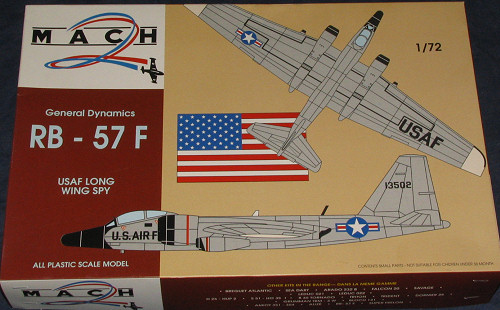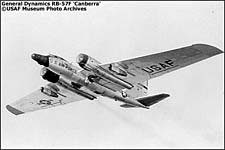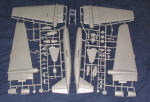
| KIT: | Mach 2 1/72 RB-57F |
| KIT #: | 019 |
| PRICE: | $82.00 MSRP |
| DECALS: | One option |
| REVIEWER: | Scott Van Aken |
| NOTES: | Deceptively easy looking short run. |

| HISTORY |
 The
RB-57F was the result of an Air Force request for a high altitude reconnaissance
aircraft with better performance than the RB-57D. Because General Dynamics was
responsible for contract maintenance on the -D model, the USAF asked for a
conversion proposal for the new aircraft which was to become the RB-57F. A
prototype conversion contract was awarded in the fall of 1962 and the first
aircraft made its first flight on 23 June 1963.
The
RB-57F was the result of an Air Force request for a high altitude reconnaissance
aircraft with better performance than the RB-57D. Because General Dynamics was
responsible for contract maintenance on the -D model, the USAF asked for a
conversion proposal for the new aircraft which was to become the RB-57F. A
prototype conversion contract was awarded in the fall of 1962 and the first
aircraft made its first flight on 23 June 1963.
The RB-57F design incorporated many major changes. The first was the greatly enlarged wing. The wing had a span of more than 122 feet; 14 feet more than the RB-57D and nearly double that of a B-57B. The second obvious change was the replacement of the Wright J65 turbojets with Pratt & Whitney TF33 turbofan engines. The TF33s gave the aircraft more than double the thrust of the -B model. The RB-57F was also capable of being fitted with two Pratt & Whitney J60 turbojets which were mounted in pods and could be attached to the wings outboard of the TF33s. These auxiliary engines were only for use at altitude, in fact, they were not equipped with starters and had to be air started while the aircraft was in flight. At altitudes above 40,000 feet, the J60s generated about 3,300 lbs. of thrust each and increased the maximum altitude of the RB-57F by 2,000 to 3,000 feet. The size of the tail was also greatly increased. The height of the vertical stabilizer was increased to 19 feet and combined with an increase in the width doubled the area of the stabilizer which was necessary for yaw control at very high altitudes (up to 80,000 ft.). The electronics were also updated on the -F model. The nose of the aircraft was lengthened to house sophisticated navigational equipment along with sensitive detection devices for gathering electronic/signal intelligence. The wings had four hard points various camera and air sampling pods could be mounted when the J60 engine pods were removed.
A total of 21 aircraft were modified by General Dynamics to the RB-57F configuration: 3 RB-57As, 14 B-57Bs and 4 RB-57Ds. Because of the extensive changes incorporated into the -F model, the aircraft were given new 1963 serial numbers as they were completed. Most of the -F models operated by the US Air Force was assigned as weather reconnaissance aircraft and used in part to measure radiation levels after above ground nuclear weapons tests conducted by other countries.
| TYPE RB-57F |
Number Built/Converted 21 (cv) |
Remarks Big wing, new engines |
Notes: SPECIFICATIONS PERFORMANCE |
||
| THE KIT |
 This
one comes in a rather largish box and when one opens it, there are two large
sprues of plastic, and a smaller one of thickish clear plastic that really isn't
that clear. No photo etch, no resin or any other exotic materials. Doesn't
really seem to be worth $82, but I got mine for well less than a third of that
from a show vendor.
This
one comes in a rather largish box and when one opens it, there are two large
sprues of plastic, and a smaller one of thickish clear plastic that really isn't
that clear. No photo etch, no resin or any other exotic materials. Doesn't
really seem to be worth $82, but I got mine for well less than a third of that
from a show vendor.
OK, I know you are waiting for a litany of things wrong. While I'm sure that there are shape issues that I don't know about (since I don't compare things with plans), I can tell you that things look very much like an RB-57. The plastic has a rather 'pebbly' surface texture and all the largish bits have ejector pin towers on one side. Sprue attachment points also intrude into the mating surfaces of many parts, so one will spend a bit of time cleaning things up. The tail planes are one piece castings with nicely done vortex generators on both sides. Since the parts are a bit thick, there are sink areas on both, some of which are under the vortex generators, making fixing this a challenge to say the least.
There is detail in the gear wells, with the main wells seeming a tad shallow. The nicely molded main gear doors have sink areas on the outside, but should be easy to fix. The cockpit is a tub with two seats (replacements suggested), instrument panels, and control column in the front. The wing jet pods are fairly well molded and both engines have blanking plates to prevent see-through. Nothing fancy and adequate to do the job. The nose cone is in two pieces. No weight information is provided, but I'd be surprised if some wasn't needed. I'd leave off the nose cone until near the end to be sure I got enough in there. The main landing gear are fair, but not really that crisply done. In fact, the same can be said about the entire kit in general as what detail is provided is a tad soft. All this is quite standard on a short run kit and buyers of these kits pretty well expect this.
 Instructions
are really a joke. There are four construction drawings, with some painting
information scattered about in both French and English. References are to the
box top for more info when it comes to decal placement. The sheet provided is
quite matte, quite generic, and with only fair detail. The fuselage insignia are
off register as are most of the smaller markings. One would have hoped for some
color in terms of a "WEATHER" band on the fin or something. I'd recommend
scrounging the spare decal bits for markings when doing this. The aircraft is
overall unpainted metal with white wing tips, black engine fronts and black wing
walk markings. These walk way markings will have to be applied from strip
decals.
Instructions
are really a joke. There are four construction drawings, with some painting
information scattered about in both French and English. References are to the
box top for more info when it comes to decal placement. The sheet provided is
quite matte, quite generic, and with only fair detail. The fuselage insignia are
off register as are most of the smaller markings. One would have hoped for some
color in terms of a "WEATHER" band on the fin or something. I'd recommend
scrounging the spare decal bits for markings when doing this. The aircraft is
overall unpainted metal with white wing tips, black engine fronts and black wing
walk markings. These walk way markings will have to be applied from strip
decals.
| CONCLUSIONS |
Well, if the kit is so poorly done, then why buy it? This is a case where the desire to have the subject over-rides the 'common sense' circuitry. I can tell you that my skills are at a level where I know that I can make a nice model out of this. Perhaps (actually, probably) not a contest model, but something neat to add to the shelf. Let the others do the Tamiya P-47s and Mustangs. For me it is the odd and unusual every time.
Thanks to the kind vendors in Memphis who allowed me to give them money for their wares!
February 2006
| REFERENCES |
Historical section proudly pinched from http://www.wpafb.af.mil/museum/research/rsrch.htm
If you would like your product reviewed fairly and quickly by a site that has over 300,000 visitors a month, please contact me or see other details in the Note to Contributors.